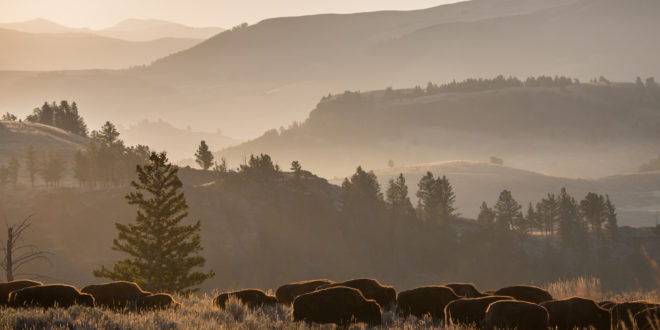600 to 900 Yellowstone bison could be culled this winter through hunting and slaughter, according to bison managers.
That number, while lower than the estimate offered last year, could still result in a population decline for Yellowstone bison.
According to the Bozeman Daily Chronicle, state, federal and tribal officials under the Interagency Bison Management Plan (IBMP) met this week at Chico Hot Springs to finalize details of this year’s bison management season. All parties agreed the population should decrease or remain stable.
We previously reported that Yellowstone biologists estimated there were approximately 4,800 bison in the Yellowstone herd as of August 2017. At this time last year, the count was approximately 5,500.
Last winter, over 1,200 bison were hunted or slaughtered under IBMP operations, the largest number of bison killed in recent memory.
Following the release of the survey, Yellowstone bison biologists Chris Geremia, Rick Wallen and PJ White said no more than 1,250 bison should be culled this year in order to keep the population stable. The 600 to 900 bison range falls well below this suggested quota.
We previously reported IBMP agencies were stuck on how to update the plan, first enacted in 2000, to better account for bison movement across the landscape and account for changes in understanding of bison dynamics. This understanding—and memory of the stalemate from last spring—likely powered some of) the impetus for a smaller cull proposal.
Indeed, according to the Chronicle, this more conservative proposal came after a study showed Yellowstone’s central bison herd, nominally untouched by IBMP efforts, which primarily take place in northern Yellowstone, had declined significantly in 2016, prompting concerns about the herd’s future. From the Chronicle:
Biologists talk about the population in two groups — the northern herd, which migrates out of the park near Gardiner, and the central herd, which usually comes out near West Yellowstone. During surveys this summer, park staff counted nearly 4,000 bison in the northern herd, virtually no change from 2016. But they counted fewer than 850 in the central herd — a more than 40 percent decrease from 2016.
PJ White, a Yellowstone biologist, said that means the herds are intermingling and that members of the central herd are likely migrating out on the north side of the park, where 92 percent of the removals take place.
“The continued culling and even harvest in the north will continue to remove many central herd animals,” White said.
Carl Scheeler, with the Confederated Tribes of the Umatilla Indian Reservations, whose members hunt bison in Montana, said that finding should lead to a conservative removal goal so biologists can further study the impact of a decline in the central herd.
“We took a big bite last year,” Scheeler said. “In doing so, we found a secondary impact we weren’t expecting.”
Scheeler and others argued that the data should lead to limited use of the trap, which hunters worry will capture bison they could otherwise shoot. But others pushed back, saying hunting alone won’t reach the removal goal and that they don’t want to allow the population to grow.
“We could have a mild winter and not many bison (leaving the park),” said Mike Volesky, chief of operations for Montana Fish, Wildlife and Parks. “There’s some danger of not taking advantage of the opportunity.”
The Chronicle reports that Yellowstone officials will “attempt to coordinate” work at the Stephens Creek Bison Capture Facility with scheduled hunts, which take place over the winter.
Currently, Yellowstone is poised to convert part of Stephens Creek into a bison quarantine facility, where bison will be screened and cured of brucellosis, a disease that can cause cattle to abort their young and necessitates quarantining and/or liquidating infected cattle. Fears of bison transmitting brucellosis to cattle is what led to the existence of the IBMP in the first place.
However, there has never been a documented case of bison-to-cattle brucellosis transmission. Further, new studies show elk are far more likely to transmit the disease to cattle.
According to the Chronicle, discussions of the Yellowstone bison hunt and trapping operations are ongoing, with officials hoping to have 250 to 400 bison north of Mammoth Hot Springs.
Hunting is a contentious issue around this boundary of the park, with tensions apparent between tribal hunters and residents of Gardiner, Montana, which serves as the north entrance to Yellowstone. Last January, the U.S. Forest Service instituted two temporary “no shooting areas” outside Gardiner—near the McConnell Fishing Access (east bank) and in Beattie Gulch—which are two popular hunting spots.
In the past, Gardiner residents have complained of loud gunfire and gut piles by the county road.
According to Jeremy Wolf of the Confederated Tribes of the Umatilla Indian Reservation, officials are discussing a possible cap on the number of hunters allowed around Gardiner during the bison hunt. The Chronicle reports four of the five tribes under the IBMP have sought to address this issue as well.
 Yellowstone Insider Your Complete Guide to America's First National Park
Yellowstone Insider Your Complete Guide to America's First National Park





